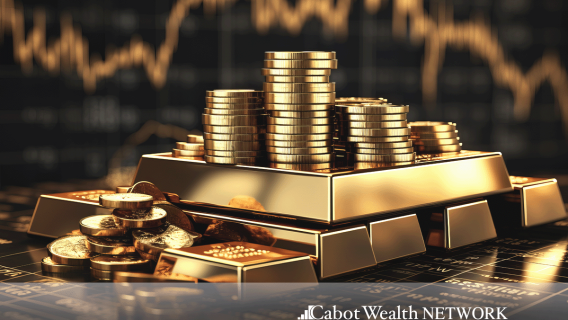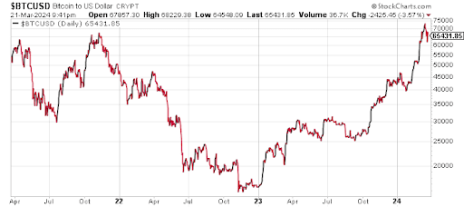With the resurgence (yet again) of Bitcoin, we’re once again reading headlines comparing it to “digital gold” or alluding to it as the gold of the 21st century.
And perhaps the comparison is apt, given that Bitcoin is synonymous with overnight prosperity in a way that few other asset classes can claim to be.
“Crypto millionaire” is right up there with “we’ve struck oil,” or “we found gold” in the American lexicon as a shorthand for unexpected riches.
But beyond that shorthand, Bitcoin, gold and oil have more in common than you might think.
The wildcatters and prospectors that drill and mine for oil and gold respectively no longer make the average investor rich.
To wit: the VanEck Gold Miners ETF (GDX) and the Energy Select Sector SPDR Fund (XLE) – funds whose holdings include some of the top public companies in the gold mining and energy industries – are long past their peaks. The GDX, whose top holdings include gold mining stocks Newmont (NEM), Barrick Gold (GOLD) and Franco-Nevada (FNV), trades at 30 a share today – about where it was a decade ago, even as the price of gold itself has never been more valuable, currently worth more than $2,000 an ounce.
The XLE, meanwhile, which boasts some of the biggest energy stocks out there – Exxon Mobil (XOM), Chevron (CVX) and ConocoPhillips (COP) – trades in the low 90s, just like it did in 2014.
Investing in either fund 10 years ago would have been the equivalent of putting your money in a traditional, ultra-low-yield savings account at your local bank.
Of course, both asset classes have had their moments. From late 2020 to late 2022, energy stocks more than tripled as oil prices spiked to 14-year highs above $120 a barrel. Gold’s big moment came in 2020 when prices soared as investors fled to safety in droves as Covid shut down the world; the GDX more than doubled in just four months.
But, in the aggregate, gold and oil have been mostly stagnant. The only way to make money on either asset class over the last decade-plus was if you picked your spots – and sold high. Neither are the set-it-and-forget-it havens they were in the 20th century.
Which brings us back to Bitcoin – the new gold – a more exciting, digital version of an alternative currency that maintains, and in fact improves, its value over time. Except … it doesn’t.
That’s a three-year chart of Bitcoin prices, which despite more than tripling since the start of 2023 and touching all-time highs, are trading at the same level that they were three years ago. Now, if you had the foresight to invest in Bitcoin four years ago, five years ago, six years ago, yes – you’ve made a LOT of money. But that can change in a matter of months.
Just look at that nosedive from late 2021 to late 2022, when Bitcoin prices plummeted from highs above 65,000 all the way to 16,000 in a year. At that point, the digital currency was below its 2017 peak. And that’s been its pattern – higher highs typically culminating at the apex of a bull market in stocks, followed by sharp, painful pullbacks in which Bitcoin prices lose half, two-thirds, or even three-quarters of their value in a matter of months.
Sure, you could blame it on early growing pains for an asset that wasn’t even invented until 2009. But unlike gold or oil, Bitcoin still has no practical function in the real world. You can’t use Bitcoin to buy your groceries, make a car payment or go to the movies. Two countries – El Salvador and the Central African Republic – tried and failed to make it legal tender. It’s still more a theoretical currency than an actual one. Its only real utility is as an investment.
And as the chart shows, there’s a shelf life on that investment. Bitcoin is subject to the whims of the market and is purely a bull market play. It’s a very good one, mind you – just look at that spike from the March 2020 Covid-induced market bottom to the first top in April 2021. Also, just look at what it’s done in the last five months since this new bull market really got going. If you time it right, you can make huge profits on Bitcoin.
But only as a short-term investment. Its entire, volatile history shows that it will only stay at elevated levels for so long before it plunges again, and the plunges are fairly predictable: 2018 (down year for the market), February 2020 (Covid market crash), and 2022 (bear market). The next market downturn will hurt stocks, at least in the short term. But it will crush Bitcoin. So I wouldn’t recommend treating Bitcoin as a long-term investment.
Milk Carton Assets
Like a gallon of milk, all three of the popular asset classes I’ve just mentioned have expiration dates. Gold and oil’s fastest growth periods are long behind them; Bitcoin’s are fleeting and fickle since the asset itself has no real-world utility, and likely won’t anytime soon. If I had to choose one to add to my portfolio as a short-term investment, Bitcoin is the clear answer, especially now that Bitcoin ETFs have made investing in the fake digital currency more accessible.
But if you do invest in Bitcoin, I’d keep a close eye on it and take profits on the way up regularly. That’s true of most stocks too. But stocks are shares of companies, the majority of which grow over time, which is why the market has grown over time throughout its history. Bitcoin has little history, no underlying company and no product lineup to attract new customers. Its trajectory is almost entirely dependent on whatever stocks are doing.
Speaking of stocks, I recommend a new one every week in my Cabot Stock of the Week advisory, which features the top stock picks from some of Cabot’s best investment analysts. And right now, my portfolio is doing quite well, with an average gain well north of 30%. So if you’d prefer to do some long-term stock investing, you can sign up for Stock of the Week by clicking here.


